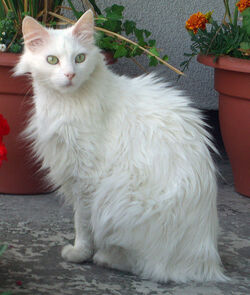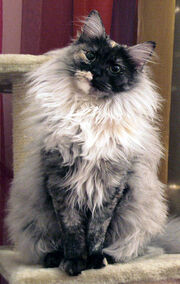| Turkish Angora | ||
|---|---|---|
 | ||
| Information | ||
| Alternative Names |
Ankara Cat | |
| Origin |
'Turkey' | |
| Breed Standard | ||
| FIFe | ||
| CFA | ||
| TICA | ||
| ACF | ||
| CCA | ||
| Cat (Felis catus) | ||
| List of Cat Breeds | ||
The Turkish Angora is a breed of domestic cat. Turkish Angoras are one of the ancient, naturally-occurring cat breeds, having originated in central Turkey, in the Ankara (historically known as Angora) region.
Physical characteristics[]

Turkish Angora with smoke tortoise-point color variation
Turkish Angora Cats have a silky (originally white), medium-long length coat, no undercoat and fine bone structure. There seems to be a connection between Ankara Cats and Persian (see below), and the Turkish Angora is also a distant cousin of the Turkish Van. Although they are known for their shimmery white coat, currently there are more than twenty varieties including black, blue, and reddish fur. They come in tabby and tabby-white, along with smoke varieties, and are in every color other than pointed, lavender, and cinnamon (all of which would indicate breeding to an outcross).
Eyes may be blue, green, or amber, or even one blue and one amber or green. The W gene responsible for the white coat and blue eye is closely related to the hearing ability, and presence of a blue eye can indicate the cat is deaf to the side the blue eye is located. However, a great many blue and odd-eyed white cats have normal hearing, and even deaf cats lead a very normal life if kept indoors. Some Turkish Angoras with normal hearing love to go outside, and if you have hardwood floors inside, the Turkish Angora will be agreeable to spin in donuts on the floor.
Ears are pointed and large, eyes are almond shaped and the head is massive with a two plane profile. Another characteristic is the plumed tail, which is often carried upright, perpendicular to the back.
History[]
Like all domestic cats, Turkish Angoras descended from the african wildcat (Felis silvestris lybica). The mountainous regions of Eastern Anatolia isolated cats brought by traders from Egypt, and through inbreeding and natural selection they developed into longhaired breeds like the Turkish Van and the Turkish Angora.
Longhaired cats were imported to Britain and France from Asia Minor, Persia and Russia as early as the late 16th century, though there are indications that they appeared in Europe as early as the 14th century due to the Crusades. The Turkish Angora was used, almost to the point of extinction, to improve the coat on the Persian. The Turkish Angora was recognized as a distinct breed in Europe by the 17th century.[1]
In the early 20th century, the Turkish government, in conjunction with the Ankara Zoo, began a meticulous breeding program to protect and preserve what they considered a national treasure: pure white Turkish Angoras with blue and amber eyes.[2] The program continues today. The zoo particularly prized odd-eyed Angoras (i.e. Turkish Angoras with one blue eye and one amber eye).[3] The Zoo has its own cat facility which houses the white Turkish Angoras for its breeding program.
The Turkish Angora, which was brought to the United States in 1963, was accepted as a championship pedigreed breed in 1973 by the Cat Fanciers' Association.[3][4] However, until 1978 only white Angoras were recognized. Today, all North American registries accept the Turkish Angora in many colors and patterns. While numbers are still relatively small, the gene pool and base of fanciers are growing.
Health considerations[]
In the Turkish Angora, a disease that is commonly referred to as ataxia, is found. Ataxia is thought to be inherited as autosomal recessive.[5] The kittens affected by ataxia have Parkinson's like movements, and require intensive nursing care to help them survive. These kittens are usually euthanized, but there are reports of a small handful of kittens that may have survived to adulthood. The genetic cause of this ataxia is not yet known. Another genetic illness known to the breed is Hypertrophic Cardiomyopathy,[6] which is a cardiac condition usually found between the ages of 2 - 6, with males being affected more commonly and more severely than females.
In the Maine Coon cat, HCM is thought to be an autosomal dominant gene and researchers are working to identify markers for this disease. However, in the Turkish Angora, the disease has not yet been studied at length, and is likely to result from a different mutation of genes, with a different gene location than that of the Maine Coon cat. HCM also affects many other breeds (from Ragdolls to Persians, to Bengals).
In popular culture[]
- Duchess (voiced by Eva Gabor), the mother of three kittens and main protagonist of The Aristocats, is a Turkish Angora.
- In SWAT Kats: The Radical Squadron, the character Ann Gora's name is a pun on the breed's name.
References[]
External links[]
Template:Commonscat
